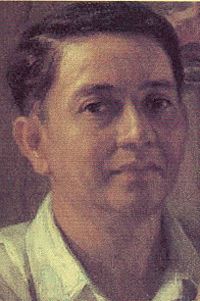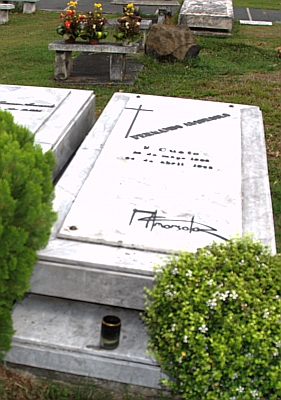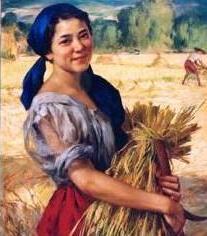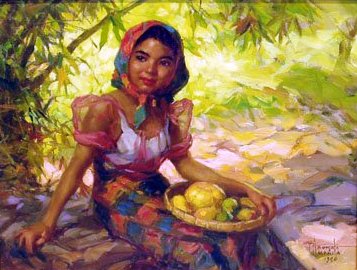<Back to Index>
- Mathematician Karl Wilhelm Feuerbach, 1800
- Painter Fernando Amorsolo y Cueto, 1892
- Dictator of Bolivia René Barrientos Ortuño, 1919
PAGE SPONSOR


Fernando Amorsolo y Cueto (May 30, 1892 – April 24, 1972) is one of the most important artists in the history of painting in the Philippines. Amorsolo was a portraitist and painter of rural Philippine landscapes. He is popularly known for his craftsmanship and mastery in the use of light. Born in Paco, Manila, he earned a degree from the Liceo de Manila Art School in 1909.
Fernando Amorsolo was born on May 30, 1892 in the Paco neighborhood, when Manila was still under Spanish sovereignty, to Pedro Amorsolo, a book keeper, and Bonifacia Cueto. Amorsolo spent his childhood in Daet, Camarines Norte, where he studied in a public school and was tutored at home in Spanish language reading and writing. After his father’s death, Amorsolo and his family moved to Manila to live with Don Fabian de la Rosa, his mother's cousin and a Philippine painter. At the age of 13, Amorsolo became an apprentice to De la Rosa, who would eventually become the advocate and guide to Amorsolo's painting career. During this time, Amorsolo's mother embroidered to earn money, while Amorsolo helped by selling water color postcards to a local bookstore for 10 Philippine peso|centavos each. Amorsolo's brother, Pablo Amorsolo, was also a painter. Amorsolo's first success as a young painter came in 1908, when his painting Leyendo el periódico took second place at the Bazar Escolta, a contest organized by the Asociacion Internacional de Artistas. Between 1909 and 1914, Amorsolo enrolled at the Art School of the Liceo de Manila, where he earned honors for his paintings and drawings.
After graduating from the Liceo, he entered the University of the Philippines' School of Fine Arts, where De la Rosa worked at the time. During college, Fernando Amorsolo's primary influences were the Spanish people court painter Diego Velazquez, John Singer Sargent, Anders Zorn, Claude Monet, Pierre-Auguste Renoir, but mostly his contemporary Spanish masters Joaquín Sorolla Bastida and Ignacio Zuloaga. Amorsolo's most notable work as a student at the Liceo was his painting of a young man and a young woman in a garden, which won him the first prize in the art school exhibition during his graduation year. To make money during school, Amorsolo joined competitions and did illustrations for various Philippine publications, including Severino Reyes’ first novel in Tagalog language, Parusa ng Diyos (God’s Punishment), and Iñigo Ed. Regalado's Madaling Araw (Dawn). He also illustrated for the religious Pasion books. Amorsolo graduated with medals from the University of the Philippines in 1914.
After graduating from the University of the Philippines, Amorsolo worked as a technical drawing|draftsman for the Bureau of Public Works, as a chief artist at the Pacific Commercial Company, and as a part-time instructor at the University of the Philippines (where he would work for 38 years). After three years as an instructor and commercial artist, Amorsolo was given a grant to study at the Academia de San Fernando in Madrid, Spain by Filipino businessman Enrique Zobel de Ayala. During his seven months in Spain, Amorsolo sketched at museums and along the streets of Madrid, experimenting with the use of light and color. Through De Ayala’s grant, Amorsolo was also able to visit New York City, where he encountered postwar impressionism and cubism, which would be major influences on his work.
Amorsolo set up his own studio upon his return to Manila and painted prodigiously during the 1920s and the 1930s. His Rice Planting (1922), which appeared on posters and tourist brochures, became one of the most popular images of the Commonwealth of the Philippines. Beginning in the 1930s, Amorsolo's work was exhibited widely both in the Philippines and abroad. His optimistic, pastoral images set the tone for Philippine painting before World War II. Except for his darker World War II era paintings, Amorsolo painted quiet and peaceful scenes throughout his career.
Amorsolo was sought after by influential Filipinos including Luis Araneta, Antonio Araneta and Jorge B. Vargas. Amorsolo also became the favorite Philippine artist of United States officials and visitors in the Philippines. Due to his popularity, Amorsolo had to resort to photographing his works and pasted and mounted them in an album. Prospective patrons could then choose from this catalogue of his works. Amorsolo did not create exact replicas of his trademark themes; he recreated the paintings by varying some elements.
His works later appeared on the cover and pages of children's textbooks, in novels, in commercial designs, in cartoons and illustrations for the Philippine publications such as The Independent, Philippine Magazine, Telembang, El Renacimiento Filipino, and Excelsior. He was the director of the University of the Philippine’s College of Fine Arts from 1938 to 1952.
During the 1950s until his death in 1972, Amorsolo averaged to finishing 10 paintings a month. However, during his later years, diabetes, cataracts, arthritis, headaches, dizziness and the death of two sons affected the execution of his works. Amorsolo underwent a cataract operation when he was 70 years old, a surgery that did not impede him from drawing and painting. Two months after being confined at the St. Luke’s Hospital in Manila, Amorsolo died of heart failure on April 24, 1972 at the age of 79.
Four days after his death, Amorsolo was conferred as the first National Artist in Painting at the Cultural Center of the Philippines by then President Ferdinand Marcos.
During
his lifetime, Amorsolo was married twice and had 14 children. In 1916,
he married Salud Jorge, with whom he had six children. After Jorge’s
death in 1931, Amorsolo married Maria del Carmen Zaragoza, with whom he
had eight more children. Among her daughters are Sylvia Amorsolo Lazo
and Luz Amorsolo. Five of Amorsolo’s children became painters
themselves. Amorsolo was a close friend to the Philippine sculptor
Guillermo Tolentino, the creator of the Caloocan City monument for
Philippine hero Andres Bonifacio. Amorsolo is best known for his illuminated landscapes, which
often portrayed traditional Filipino customs, culture, fiestas and
occupations. His pastoral works presented "an imagined sense of
nationhood in counterpoint to American colonial rule" and were
important to the formation of Filipino national identity. He was educated in the classical tradition and aimed "to achieve his Philippine version of the Greek ideal for the human form." In his paintings of Filipina women, Amorsolo rejected Western ideals of beauty in favor of Filipino ideals and was fond of basing the faces of his subjects on members of his family. He said that the women he painted should have Amorsolo used natural light in his paintings and developed the backlighting technique, which became his artistic trademark and his greatest contribution to Philippine painting. In
a typical Amorsolo painting, figures are outlined against a
characteristic glow, and intense light on one part of the canvas
highlights nearby details. Philippine sunlight was a constant feature of Amorsolo's work; he is believed to have painted only one rainy-day scene. Amorsolo also painted a series of historical paintings on pre-Colonial and Spanish Colonization events. Amorsolo’s Making of the Philippine Flag, in particular, was widely reproduced. His The First Baptism in the Philippines required numerous detailed sketches and colored studies of its elements. These diverse elements were meticulously and carefully set by the artist before being transferred to the final canvas. For his pre-colonial and 16th-century depiction of the Philippines, Amorsolo referred to the written accounts of Antonio Pigafetta, other available reading materials, and visual sources. He consulted with the Philippine scholars of the time, H. Pardo de Tavera and Epifanio de los Santos. Amorsolo also painted oil portraits of Philippine General Emilio Aguinaldo, Philippine presidents,
and other prominent Filipino individuals such as Don ALfredo Jacob and
Dona Pura Garchitorena Toral, a member of the prominent Familia
Garchitorena of Camarines Sur. He also did a portrait of US Senator Warren Grant Magnuson (1905 – 1989), of the Democratic Party from Washington, whom the Warren G. Magnuson Health Sciences Building at the University of Washington and the Warren G. Magnuson Clinical Center at the National Institutes of Health in Bethesda, Maryland are named after. After
the onset of World War II, Amorsolo's typical pastoral scenes were
replaced by the depictions of a war-torn nation. During the Japanese occupation of the Philippines during World War II, Amorsolo spent his days at his home near the Japanese garrison, where he sketched war scenes from the house's windows or rooftop. During
the war, he documented the destruction of many landmarks in Manila and
the pain, tragedy and death experienced by Filipino people, with his
subjects including "women mourning their dead husbands, files of people
with pushcarts and makeshift bags leaving a dark burning city tinged
with red from fire and blood." Amorsolo
frequently portrayed the lives and suffering of Filipina women during
World War II. Other WWII era paintings by Amorsolo include a portrait in absentia of General Douglas MacArthur as well as self-portraits and paintings of Japanese occupation soldiers. In 1948, Amorsolo’s wartime paintings were exhibited at the Malacañang Presidential Palace. Amorsolo's supporters consider his portrayals of the countryside as "the true reflections of the Filipino Soul." Amorsolo
has been accused, however, of succumbing to commercialism and merely
producing souvenir paintings for American soldiers. Critic Francisco Arcellana wrote
in 1948 that Amorsolo's paintings "have nothing to say" and that they
were not hard to understand because "there is nothing to understand." Critics
have criticized Amorsolo's portraits of Philippine Commonwealth
personalities, his large, mid-career anecdotal works, and his large
historical paintings. Of
the latter, critics have said that his "artistic temperament was simply
not suited to generating the sense of dramatic tension necessary for
such works." Another
critic, however, while noting that most of Amorsolo's estimated ten
thousand works were not worthy of his talent, argues that Amorsolo's
oeuvre should nonetheless be judged by his best works instead of his
worst. Amorsolo's
small landscapes, especially those of his early career, have been
judged as his best works, "hold[ing] well together plastically." Amorsolo may "be considered a master of the Philippine landscape as landscape, even outranking Luna and Hidalgo who also did some Philippine landscapes of the same measurements."
In
2003, Amorsolo's children founded the Fernando C. Amorsolo Art
Foundation, which is dedicated to preserving Fernando Amorsolo’s
legacy, promoting his style and vision, and preserving a national
heritage through the conservation and promotion of his works. At a 2001 auction in Wellesley, Massachusetts, two original 1950s paintings by Amorsolo, The Cockfight and Resting Under the Trees, were bought by a New Jersey collector for $36,000 and $31,500, respectively. During a 2002 episode of Antiques Roadshow, a Sotheby's
antiques appraiser estimated that an attendee's signed 1945 rural
landscape painting by Amorsolo could fetch between $30,000 and $50,000
at auction. At a 1996 Christie's auction, Amorsolo's The Marketplace went for $174,000. In April 2002, Portrait of Fernanda De Jesus was bought for US$ 377,947. In November 30, 2009, the Family Gathering Fruit sold for USD 77,257 at Christie's. In December 6, 2009, Fruit Gatherer was auctioned off in Maryland,
in record-breaking manner, topping 19th and 20th century European and
American paintings. In May 2010, the highest priced Amorsolo painting
was auctioned off at Christie's for about US$ 440,000.
Amorsolo was an incessant sketch artist, often drawing sketches at his home, at Luneta Park, and in the countryside. He drew the people he saw around him, from Filipino farmers to city-dwellers coping with the Japanese occupation. Amorsolo's impressionistic tendencies, which may be seen in his paintings as well, were at their height in his sketches. His figures were not completely finished but were mere "suggestions" of the image.
The
volume of paintings, sketches and studies of Amorsolo is believed to
have reached more than 10,000 pieces. Amorsolo was an important
influence on contemporary Filipino art and artists, even beyond the
so-called "Amorsolo school." Amorsolo's
influence can be seen in many landscape paintings by Filipino artists,
including early landscape paintings by abstract painter Federico Aguilar Alcuaz.




